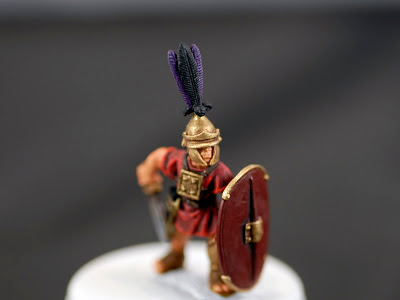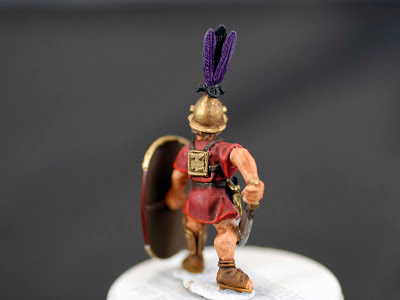This figure is a Roman s
ignifer for my nearly completed unit of Republican hastati. The
signifer was a critical component of the military command structure and carried the important
signa of his
centuria into battle. The
centuria of the Roman army was the smallest disciplinary unit of the legion (the smallest non-disciplinary unit within the legion was the tent group or
contubernium, composed of eight men who shared a tent, a mule, and eating equipment) with two
centuriae comprising a single maniple. The most ancient standards employed by the Romans is said to have been a handful (
manipulus) of straw fixed to the top of a spear or pole. Hence the company of soldiers belonging to it was called a
maniple.
The
signa served the very practical military purpose as a recognition signal and a rallying point within the chaos of a battle field. The importance of the
signa is shown by the numerous phrases and commands which express the movements of the legion:
signa convellere, efferre, tollere is 'to strike camp';
signa proferre, when the whole line advances;
signa constituere, 'to halt';
signa convertere, 'to wheel round';
a signis discedere,
signa deserere, 'to take flight';
signa referre, 'to retreat';
signa conferre, 'to engage in hand-to-hand combat' and also 'to rally';
ad signa convenire, 'to re-assemble'.
But the standard had a second, and I would argue an even more significant, purpose that found its roots deeply planted in military ideological, symbolic and religious meanings. Affixed to the staff of the
signa were the military decorations that the fighting unit had won in battle for acts of courage, military successes and martial prowess. This prominent and permanent display of these awards strengthened the pride, unity and brotherhood of the unit. The standard of the
centuria became so critical to the ideology and adoration of the soldiers that a cult of the
signa would later appear. This military cult ascribed sacredness to the
signa and introduced worshiping the standard as a deity. Soldiers decorated, anointed and even made sacrifices to the
signa during certain military ceremonial events.


























